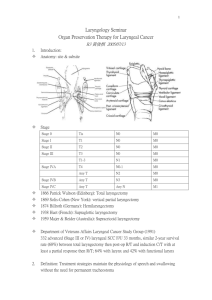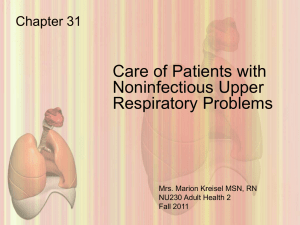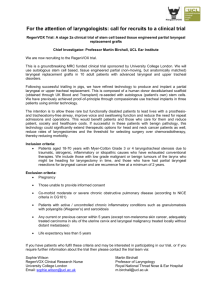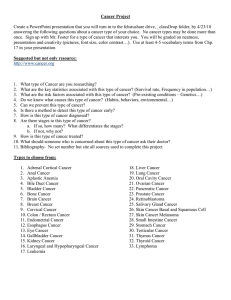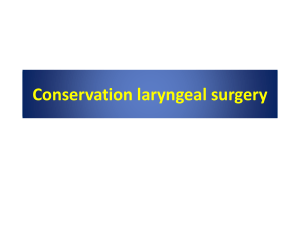What are the factors that negatively and positively affect long
advertisement
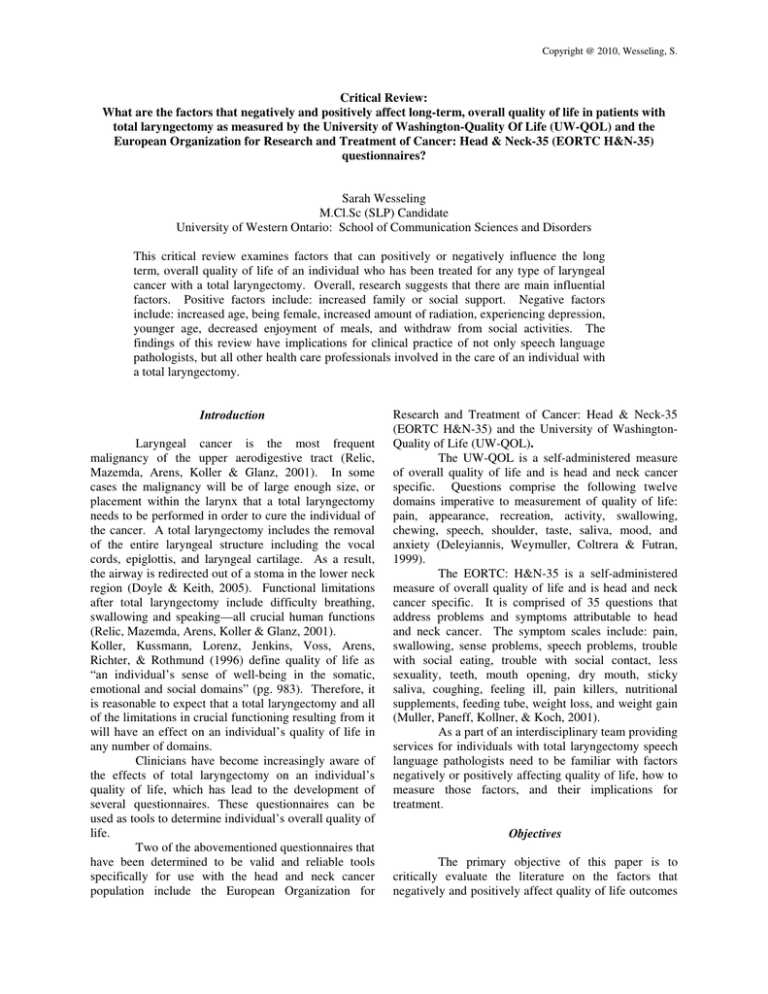
Copyright @ 2010, Wesseling, S. Critical Review: What are the factors that negatively and positively affect long-term, overall quality of life in patients with total laryngectomy as measured by the University of Washington-Quality Of Life (UW-QOL) and the European Organization for Research and Treatment of Cancer: Head & Neck-35 (EORTC H&N-35) questionnaires? Sarah Wesseling M.Cl.Sc (SLP) Candidate University of Western Ontario: School of Communication Sciences and Disorders This critical review examines factors that can positively or negatively influence the long term, overall quality of life of an individual who has been treated for any type of laryngeal cancer with a total laryngectomy. Overall, research suggests that there are main influential factors. Positive factors include: increased family or social support. Negative factors include: increased age, being female, increased amount of radiation, experiencing depression, younger age, decreased enjoyment of meals, and withdraw from social activities. The findings of this review have implications for clinical practice of not only speech language pathologists, but all other health care professionals involved in the care of an individual with a total laryngectomy. Introduction Laryngeal cancer is the most frequent malignancy of the upper aerodigestive tract (Relic, Mazemda, Arens, Koller & Glanz, 2001). In some cases the malignancy will be of large enough size, or placement within the larynx that a total laryngectomy needs to be performed in order to cure the individual of the cancer. A total laryngectomy includes the removal of the entire laryngeal structure including the vocal cords, epiglottis, and laryngeal cartilage. As a result, the airway is redirected out of a stoma in the lower neck region (Doyle & Keith, 2005). Functional limitations after total laryngectomy include difficulty breathing, swallowing and speaking—all crucial human functions (Relic, Mazemda, Arens, Koller & Glanz, 2001). Koller, Kussmann, Lorenz, Jenkins, Voss, Arens, Richter, & Rothmund (1996) define quality of life as “an individual’s sense of well-being in the somatic, emotional and social domains” (pg. 983). Therefore, it is reasonable to expect that a total laryngectomy and all of the limitations in crucial functioning resulting from it will have an effect on an individual’s quality of life in any number of domains. Clinicians have become increasingly aware of the effects of total laryngectomy on an individual’s quality of life, which has lead to the development of several questionnaires. These questionnaires can be used as tools to determine individual’s overall quality of life. Two of the abovementioned questionnaires that have been determined to be valid and reliable tools specifically for use with the head and neck cancer population include the European Organization for Research and Treatment of Cancer: Head & Neck-35 (EORTC H&N-35) and the University of WashingtonQuality of Life (UW-QOL). The UW-QOL is a self-administered measure of overall quality of life and is head and neck cancer specific. Questions comprise the following twelve domains imperative to measurement of quality of life: pain, appearance, recreation, activity, swallowing, chewing, speech, shoulder, taste, saliva, mood, and anxiety (Deleyiannis, Weymuller, Coltrera & Futran, 1999). The EORTC: H&N-35 is a self-administered measure of overall quality of life and is head and neck cancer specific. It is comprised of 35 questions that address problems and symptoms attributable to head and neck cancer. The symptom scales include: pain, swallowing, sense problems, speech problems, trouble with social eating, trouble with social contact, less sexuality, teeth, mouth opening, dry mouth, sticky saliva, coughing, feeling ill, pain killers, nutritional supplements, feeding tube, weight loss, and weight gain (Muller, Paneff, Kollner, & Koch, 2001). As a part of an interdisciplinary team providing services for individuals with total laryngectomy speech language pathologists need to be familiar with factors negatively or positively affecting quality of life, how to measure those factors, and their implications for treatment. Objectives The primary objective of this paper is to critically evaluate the literature on the factors that negatively and positively affect quality of life outcomes Copyright @ 2010, Wesseling, S. in individuals with total laryngectomy. The secondary objective is to summarize potential factors which can be used by clinicians as predictors of quality of life outcomes for their clients. Methods Search Strategy Computerized databases CINAHL, SCOPUS, PubMed, and Google Scholar were searched using the following search strategy: “quality of life” AND “laryngectomy”. Articles were limited to those published in English. Abstracts were retrieved for articles which met the search criteria and full articles retrieved for those which contributed to the purpose of this review. Reference lists were reviewed from articles retrieved for any further articles which contributed to the purpose of this review. Selection Criteria Studies included in this critical review were required to have included participants with total laryngectomy, and to report on factors affecting quality of life outcome measures using either the University of Washington-Quality of Life questionnaire or the European Organization for Research and Treatment of Cancer: Head and Neck-35 questionnaire. Laryngectomees included in the papers represented a wide range of time post surgery and variable radiation amounts post laryngectomy. Data Collection Results of the literature search yielded papers on factors associated with increased or decreased quality of life in individuals with total laryngectomy. Papers from 1999-2006 described factors that could either negatively or positively affect an individual’s quality of life after total laryngectomy. Types of articles congruent with the aforementioned selection criteria included: single group posttest only (2), nonrandomized clinical trial—between groups (2), and within groups repeated measures (1). Results The following section will be separated into factors derived from the UW-QOL and those derived from the EORTC H&N-35. These two questionnaires are both valid and reliable tools for measuring quality of life in individuals with head and neck cancer, however they employ different questions in order to arrive at the same measurement outcome—a rating of an individual’s quality of life. This will be taken into consideration when compiling factors derived from each tool. UW-QOL Vilaseca, Chen & Backscheider (2006) conducted a retrospective single group posttest only study that examined the quality of life of people who had been treated for laryngeal cancer. Subjects included 49 individuals with total laryngectomy who were at least two years post laryngectomy. These subjects were recruited from a national meeting for laryngectomy survivors. Appropriate statistical analysis using the Mann-Whitney U and likelihood ratio tests were performed on the data. Analysis revealed that although subjects identified speech, appearance, and activity as the most important problems, no significant correlation was actually found between speech and quality of life. However, increased age, being female, and increased amount of radiation/chemotherapy had a negative affect on overall quality of life. Deleyiannis, Weymuller, Coltera & Futran (1999) conducted a prospective within groups— repeated measures study that examined the quality of life of people who had been treated for laryngeal cancer. Subjects included 10 individuals with total laryngectomy both one and two years post surgery to determine if and how functional disabilities affected long-term quality of life. Participants were also asked to rank the importance of each domain of QOL within the questionnaire. Appropriate statistical analysis using spearman correlation coefficients were performed on the data. Analysis revealed that neither severity of functional disability nor pain, appearance, activity, chewing, swallowing, speech, or employment were significantly correlated with overall quality of life. The researchers noted that pre and post laryngectomy scores also did not differ significantly and attributed the nonsignificant findings to the patient’s ability to cope, and their gratitude for still being alive. EORTC H&N-35 Birkhaug, Aarstad, Aarstad & Oloffson (2002) conducted a retrospective, between groups nonrandomized clinical trial that examined that quality of life of people who had been treated for laryngeal cancer. Subjects included 96 individuals with total laryngectomy who were treated between 1992 and 1997. Subjects were recruited from the Norwegian Cancer Society. In a separate study, a comparison of head and neck cancer survivors without a total laryngectomy were compared to those with a total laryngectomy to determine possible factors specific to the total laryngectomy population. Appropriate statistical analysis using the student’s t-test, Pearson’s r correlation, and MANOVA were performed on the data. Analysis revealed that gender, number of years post laryngectomy, social support from family/friends, and amount of participation with the Norwegian Society of Copyright @ 2010, Wesseling, S. Laryngectomees were not significantly correlated to overall quality of life. On the other hand, age and depression were significantly correlated with lower overall quality of life. Specifically, when the two groups were compared, no factors were found significantly distinctive to total laryngectomy. Muller, Paneff, Kollner & Kich (2001) conducted a retrospective, between groups nonrandomized clinical trial that examined the quality of life of people who had been treated for laryngeal cancer. Subjects included 137 individuals with total laryngectomy who were treated between 1989 and 1998 at the ENT Hospital of Dresden University. Subjects were grouped into chordectomy, partial laryngectomy, irradiation, laryngectomy, and laryngectomy with radiotherapy to help determine distinctive QOL predictors for each group. Appropriate statistical analysis using measures of variance and covariance were performed on the data. Analysis revealed that out of the 18 functional parameters included in the questionnaire only global health status, role, lower sexual interest, and social functioning were significantly correlated with decreased quality of life in total laryngectomees compared to the other groups. The researchers also noted that contrary to the prediction that quality of life would improve over time as coping strategies improved, a comparison of scores immediately following surgery and longer term scores were not significantly different. Relic, Mazemda, Arens, Koller & Glanz (2001) conducted a prospective single group posttest only study that examined the quality of life if people who had been treated for laryngeal cancer. Subjects included 29 individuals with total laryngectomy who were 6 years post laryngectomy. Subjects were recruited from a local self help group. Appropriate statistical analysis using standard deviations, percentages, ranges, and Person correlations were performed on the data. Analysis revealed that overall communication, talking on the phone, coughing, and decreased enjoyment of meals were significantly correlated with decreased quality of life. Increased family support was significantly correlated with increased quality of life. Discussion When considering these results, one must take into consideration the inherent limitations to summarizing results from restrictions on the sampling population, varying levels of evidence, and other methodological variables. Each of these aspects will be discussed below in further detail. Subject Selection and Characteristics Although it would appear at first glance individuals with laryngeal cancer would be quite a homogeneous population, this is not the case. There is a great deal of heterogeneity within his population when taking into consideration the following variables: specific location of cancer within laryngeal area, size of tumor, method of treatment (surgical vs. non-surgical, or a combination), personality characteristics of the individual, amount of support from family, friends, and outside sources. Therefore, although these individuals share a common characteristic (they have had and been treated for a laryngeal cancer) there are many variable characteristics that may also contribute to better or worse quality of life. Second, while each study had adequate sample size considering that individuals with laryngeal cancer comprise a smaller population than other disorders, the recruitment method of these subjects in the majority of the articles reviewed created a sampling bias. In order to avoid a sampling bias researchers must recruit subjects from a variety of locations, and by a variety of methods. Birkhaugh et al. (2002), Relic et al. (2001), and Vilaseca et al. (2006) all recruited their subjects from local self help groups only. Individuals who chose to participate in self help groups may all share an underlying common characteristic (eg. the willingness to participate in a social activity) that may influence levels of quality of life despite their participation in a self help group, therefore creating a sampling bias. To avoid this the researchers should have recruited subjects from multiple locations, not solely from self help groups. Methods As previously mentioned, two different quality of life questionnaires were part of the inclusion criteria; both the UW-QOL and the EORTC H&N-35. Although both of these questionnaires are reliable and valid tools for measuring quality of life in individuals who have been diagnosed with a head or neck cancer it still has to be taken into consideration that they employ different questions and have some differing domains. For example, the UW-QOL questionnaire includes the following domains that the EOTRC H&N-35 does not: appearance, taste, and mood (Deleyiannis et al., 1999; Muller et al., 2001). On the other hand, the EOTRC H&N-35 includes sexuality, coughing, and weight loss domains, which the UW-QOL does not (Deleyiannis et al., 1999; Muller et al., 2001). Therefore, the differing nature of these questionnaires must be taken into consideration when comparing quality of life outcomes resulting from each. A second methodological concern is the lack of control groups in several of the studies. Only two researchers, Birkhaug et al. (2002) and Muller et al. Copyright @ 2010, Wesseling, S. (2001) included control groups comprised of individuals with laryngeal cancer who had not undergone a laryngectomy as a treatment method. This allowed for determination of factors specific to laryngectomees. Deleyiannis et al. (1999), Relic et al. (2001), and Vilaseca et al. (2006) did not include control groups. A final methodological concern is the wide range of definitions of ‘long-term’ (eg. time postsurgery of each subject). Birkhaug et al. (2002) included patients from one to five years post surgery, whereas Deleyiannis et al. (1999) and Vilaseca et al. (2006) only included subjects one and two years post surgery. On a more extreme scale, Relic et al. (2001) included subjects up to six years post-surgery, and Muller et al. (2001) included those up to 12 years postsurgery. Time post-surgery may be a variable that affects quality of life therefore these wide gaps must also be taken into consideration when comparing quality of life outcomes across studies. limitations however, when considered as a whole they provide insight into future research on this topic. In order to improve existing evidence, future research should take into account: I. The methodological biases created when using more than one questionnaire to measure quality of life outcomes. II. Conducting separate research studies on how the time post-surgery affects quality of life as a single variable. III. Expanding on recruitment methods to eliminate sampling biases (eg. being sure to recruit and include some individuals who are a part of a self help group, as well as those who are not part of a self help group.) IV. Including a control group of individuals with laryngeal cancer who have not undergone total laryngectomy in order to determine factors specific to laryngectomees. Levels of Evidence Although the gold standard in research is a randomized controlled trial, given the nature and characteristics of a population with laryngeal cancer the levels of evidence included in the studies reviewed here are acceptable. Within the laryngeal cancer population there are many inherent limitations including inability to randomly assign a type or location of cancer to an individual, inability to randomly assign a treatment course to and individual, and an inability to control for outside variables that may be present in some, and not in others (eg. a recurrence). Clinical Implications Conclusion After review and comparison of each research article and taking into consideration inherent limitations previously discussed factors that negatively and positively affect overall, long-term quality of life become apparent. Factors that negatively affect overall, long-term quality of life include: increased age, being female, increased amount of radiation, experiencing depression, decreased enjoyment of meals, and withdrawal from social activities. Increased family or social support appears to be the only significant factor positively affecting overall, long-term quality of life. Recommendations While there is a sufficient body of evidence reporting on the importance of quality of life measurements and outcomes with all head and neck cancer populations, there is little on factors influencing the quality of life in individuals with a laryngeal cancer. The literature reviewed here demonstrates some The results and conclusions discussed in this critical review have important implications for speech language pathologists, as well as other health care professionals that will be working closely with a laryngeal cancer population. Despite the aforementioned limitations of the studies reviewed, the evidence indicates that there are factors that can negatively or positively affect and individual’s quality of life. Although each individual being treated for a laryngeal cancer is unique in their views and expectations for their own quality of life it is essential that speech language pathologists, along with other care providers, are educated about the main factors that may contribute so that they can in turn educate their clients. In the future, education about quality of life and factors that influence it will be an important part in treatment for all individuals with a laryngeal cancer. References Birkhaug, E. J., Aarstad, H. J., Aarstad, A. K. H., & Olofsson, J. (2002). Relation between mood, social support and the quality of life on patients with laryngectomies, European Archives of Otorhinolaryngology, 259, 197-204. Deleyiannis, F., Weymuller, E., Coltrera, M., & Futran, N. (1999). Quality of life after laryngectomy: are functional disabilities important, Head & Neck, 21, 319-324. Doyle, P. C., & Keith, R. L. (Eds.). (2005). Contemporary Considerations in the Treatment and Rehabilitation of Head and Neck Cancer: Voice, Speech and Swallowing. Austin, Texas: Pro-ed. Copyright @ 2010, Wesseling, S. Koller, M., Kussmann, J., Lorenz, W., Jenkins, M., Voss, M., Arens, E., Richter, E., & Rothmund, M. (1996). Symptom reporting in cancer patients, 77, 983-995. Muller, R., Paneff, J., Kollner, V., & Kich, R. (2001). Quality of life of patients with laryngeal carcinoma: a post-treatment study. European Archives of Otorhinolaryngology, 258, 276-280. Relic, A., Mazemda, P., Arens, C., Koller, M., & Glanz, H. (2001). Investigating quality of life and coping resources after laryngectomy. European Archives of Otorhinolaryngology, 258, 514-517. Vilaseca, I., Chen, A., & Backscheider, A. (2006). Long term quality of life after total laryngectomy. Head &Neck, 10, 313-320.
